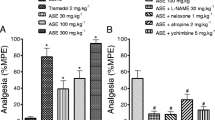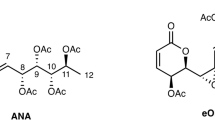Abstract
Natural products, including those derived from plants, have largely contributed to the development of therapeutic drugs. Glutamate is the main excitatory neurotransmitter in the central nervous system and it is also considered a nociceptive neurotransmitter, by acting on peripheral nervous system. For this reason, in this study we investigated the effects of the hydroalcooholic extracts from Drymis winteri (polygodial and drimanial), Phyllanthus (rutin and quercetine), Jathopha elliptica (jatrophone), Hedyosmum brasiliense (13HDS), Ocotea suaveolens (Tormentic acid), Protium kleinii (αβ-amyrin), Citrus paradise (naringin), soybean (genistein) and Crataeva nurvala (lupeol), described as having antinociceptive effects, on glutamatergic transmission parameters, such as [3H]glutamate binding, [3H]glutamate uptake by synaptic vesicles and astrocyte cultures, and synaptosomal [3H]glutamate release. All the glutamatergic parameters were affected by one or more of these compounds. Specifically, drimanial and polygodial presented more broad and profound effects, requiring more investigation on their mechanisms. The putative central side effects of these compounds, via the glutamatergic system, are discussed.
Similar content being viewed by others
References
Izquierdo I, Medina JH (1997) Memory formation: the sequence of biochemical events in the hippocampus and its connection to activity in other brain structures. Neurobiol Learn Mem 68:285–316
Ozawa S, Kamyiar H, Tsuzuki K (1998) Glutamate receptors in the mammalian cerebral nervous system. Prog Neurobiol 54:581–618
Segovia G, Porras A, Del Arco A et al (2001) Glutamatergic neurotransmission in aging: a critical perspective. Mech Ageing Dev 122:1–29
Danbolt NC (2001) Glutamate uptake. Prog Neurobiol 65:1–105
Maragakis NJ, Rothstein JD (2001) Glutamate transporters in neurologic disease. Arch Neurol 58:365–370
Maragakis NJ, Rothstein JD (2004) Glutamate transporters: animal models to neurologic disease. Neurobiol Dis 15:461–473
Meldrum BS (2000) Glutamate as a neurotransmitter in the brain: Review of Physiology and Pathology. J Nutr 130:1007S–1015S
Chen Y, Swanson RA (2003) Astrocytes and brain injury. J Cereb Blood Flow Metab 23:137–149
Attwell D (2000) Brain uptake of glutamate: food for thought. J Nutr 130:1023S–1025S
Robinson MB, Dowd LA (1997) Heterogeneity and functional properties of subtypes of sodium-dependent glutamate transporters in mammalian central nervous system. Adv Pharmacol 37:69–115
Martini LH, Souza CR, Marques PB et al (2000) Compounds extracted from Phyllantus and Jatropha elliptica inhibits binding of [3H]glutamate and [3H]GMP-PNP in rat cerebral cortex membrane. Neurochem Res 25:211–215
Scheidt C, Santos ARS, Ferreira J et al (2002) Evidence for the involvement of glutamatergic receptors in the antinociception caused in mice by the sesquiterpene drimanial. Neuropharmacology 43:340–347
Morton JF (1981) In: Thomas CC (ed) Atlas of medicinal plants in middle America-Bahamas to Yucatan. Springfield, USA p 219
Mendes GL, Santos ARS, Campos MM et al (1998) Anti-hyperalgesic properties of the extract and of the main sesquiterpene polygodial isolated from the barks of Drymis winteri (Winteraceae). Life Sci 63:369–381
Da Cunha FM, Fröde TS, Mendes GL et al (2001) Additional evidence for the anti-inflammatory and anti-allergic properties of the sesquiterpene polygodial. Life Sci 70:159–169
Beirith A, Santos ARS, Calixto JB et al (1999) Study of the antinociceptive action of the ethanolic extract and the triterpene 24-hydroxytormentic acid isolated from the stem bark of Ocotea suaveolens. Plant Med 65:50–55
Calixto JB, Sant’Ana AEG (1990) Evidence for the mechanism of the inhibitory Action of jatrophone in the isolated rat uterine muscle. Gen Pharmacol 21:117–122
Trentin AP, Santos ARS, Guedes A et al (1999) Antinociception caused by the extract of Hedyosmum brasiliense and its active principle, the sesquiterpene lactone 13-hydroxy-8,9-dehydroshizukanolide. Plant Med 65:517–521
Calixto JB, Santos ARS, Cechinel-Filho V et al (1998) A review of the genus Phyllanthus their chemistry, pharmacology and therapeutic potential. Med Res Rev 18:225–258
Calixto JB, Scheidt C, Otuki M et al (2001) Biological activity of plant extracts: novel analgesic drugs. Expert Opin Emerg Drugs 6:1–18
Otuki MF, Ferreira J, Lima FV et al (2005) Antinociceptive properties of mixture of α-amyrin and β-amyrin triterpenes: evidence for participation of protein kinase C and protein kinase A pathways. J Pharmacol Exp Therap 313:310–318
Otuki MF, Vieira-Lima F, Malheiros A et al (2005) Topical antiinflammatory effects of the ether extract from Protium kleinii and α-amyrin pentacyclic triterpene. Eur J Pharmacol 507:253–259
Geetha T, Varalakshmi P (1999) Anticomplement activity of triterpenes from Cratevea nurvala stem bark in adjuvant arthritis in rats. Gen Pharmacol 32: 495–497
Sudhahar V, Kumar SA, Varalakshmi P (2006) Role of lupeol and lupeol linoleate on lipemic-oxidative stress in experimental hypercholesterolemia. Life Sci 78:1329–1335
Dugo P, Presti ML, Ohman M et al (2005) Determination of flavonoids in citrus juices by micro-HPLC-ESI/MS. J Sep Sci 28:49–56
Kruk I, Aboul-Enein HY, Michalska T et al (2005) Scavenging of reative oxygen species by the plant phenols genistein and oleuropein. Luminescence 20:81–89
Jones DH, Matus AI (1974) Isolation of synaptic-plasma membrane from brain by combined flotation-sedimentation density gradient centrifugation. Biochim Biophys Acta 356:276–287
Fykse EM, Fonnum FJ (1988) Uptake of γ-aminobutyric acid by a synaptic vesicle fraction isolated from rat brain. J Neurochem 50:1237–1242
Tavares RG, Tasca CI, Santos CES et al (2000) Quinolinic acid inhibits uptake into synaptic vesicles from rat brain. Neuroreport 11:249–253
Naito S, Ueda T (1985) Characterization of glutamate uptake into synaptic vesicles. J Neurochem 44:99–109
Wolosker H, Souza DOG, De Méis LJ (1996) Regulation of glutamate transport into synaptic vesicles by chloride and proton gradient. J Biol Chem 271:11726–11731
Saneto RP, De Vellis J (1987) Neuronal and glial cells: cell culture of the central nervous system. In: Turner AJ, Brachelard HS (eds) Neurochemistry: a practical approach. IRL Press, Oxford, pp 27–63
Frizzo MES, Lara DR, Dahm KCS et al (2001) Activation of glutamate uptake by guanosine in primary astrocyte cultures. Neuroreport 12:879–881
Zelenaia O, Schlag BD, Gochenauer GE et al (2000) Epidermal growth receptor agonists increase expression of glutamate transporter GLT-1 in astrocytes through pathways dependent on phosphaidylinositol 3-kinase and transcription factor NF-kappaB. Mol Pharmacol 57:667–678
Dunkley PR, Heath J, Harrison SM et al (1988) A rapid Percoll gradient procedure for isolation of synaptosomes directly from an S1 fraction: homogeneity and morphology of subcelular fractions. Brain Res 441:59–71
Rocha JBT, Mello CF, Battastini AMO et al (1994) Dois procedimentos para isolar sinaptossomas usando gradientes de Percoll. Ciênc Nat Brasil 16:29–33
Migues PV, Leal RB, Mantovani M et al (1999) Synaptosomal glutamate release induced by the fraction BC2 from the venom of the sea anemone Bunadosoma caissarum. Neuroreport 1:67–70
Fontella FU, Vendite DA, Tabajara AS et al (2004) Repeated restrait stress alters hippocampal glutamate uptake and release in the rat. Neurochem Res 29:1703–1709
Lowry OH, Rosebrough NJ, Farr AL et al (1951) Protein measurement with the Folin phenol reagent. J Biol Chem 193:265–275
Corrêa P (1978) Dicionário das plantas úteis do Brasil e das exóticas cultivadas. Rio de Janeiro: Imprensa Nacional 2:112
Tratsk KS, Campos MM, Vaz ZR et al (1997) Anti-allergic effects and oedema inhibition caused by the extract of Drymis winteri. Inflamm Res 46:509–514
Mendes GL, Santos ARS, Malheiros A et al (2000) Assessment of mechanisms involved in antinociception caused by sesquiterpene polygodial. J Pharmacol Exp Ther 292:164–172
André E, Ferreira J, Melheiros A et al (2004) Evidence for the involvement of vanilloid receptor in the antinociception produced by the dialdeyde unsaturated sesquiterpenes polygodial and drimanial in rats. Neuropharmacology 46:590–597
Martini LH, Cereser L, Zanonato-Junior I et al (2006) The sesquiterpenes polygodial and drimanial in vitro affect glutamatergic transport in rat brain. Neurochem Res 31:431–438
Acknowledgements
This work was supported by FAPERGS and CNPq.
Author information
Authors and Affiliations
Corresponding author
Rights and permissions
About this article
Cite this article
Martini, L.H., Jung, F., Soares, F.A. et al. Naturally Occurring Compounds Affect Glutamatergic Neurotransmission in Rat Brain. Neurochem Res 32, 1950–1956 (2007). https://doi.org/10.1007/s11064-007-9393-y
Received:
Accepted:
Published:
Issue Date:
DOI: https://doi.org/10.1007/s11064-007-9393-y




